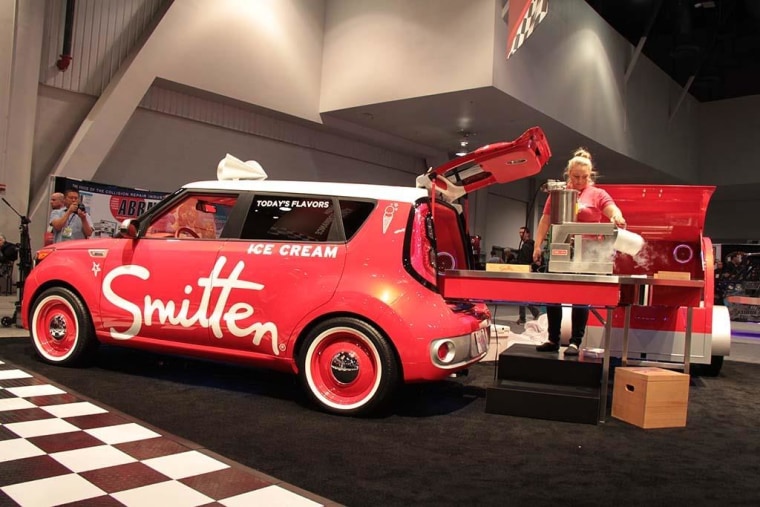It looks like an ordinary, 2015 Toyota Camry, but lift the hood and you’re in for a surprise.
Actually, you have to raise the entire body of the “Sleeper Camry” sedan, which Toyota quietly transformed into an 850-horsepower drag racer. It’s just one of the wild, weird and wacky concept vehicles unveiled at the 2014 Specialty Equipment Marketers Association annual aftermarket convention, an event known to fans around the world as the SEMA Show.
There’s been plenty written about the supposed death of the American love affair with the automobile. You’d have a hard time proving it at the Las Vegas convention center, which hosts what has become Sin City’s second-largest annual event, this year expected to draw as many as 140,000 attendees.
And that’s just for automotive and aftermarket industry insiders. For the first time, the trade organization will be holding a public event, dubbed SEMA Ignited, next week that will put 500 customized cars, trucks and crossovers on display. It’s already received nearly 9,000 advanced registrations.
“You open up the Ford performance catalog and take one of everything.”
In its early years, SEMA put a heavy focus on performance, appealing to the hot rodders and customizers who turned Los Angeles into an automotive mecca. Today, muscle is still a big draw. SEMA attendees can browse hundreds of booths showcasing the latest in modified exhaust systems, high-strength pistons, turbochargers and full “crate engines,” ready-to-go, high-performance engines that can be dropped into a car like the Chevrolet Camaro or Honda Civic.
Ford used the SEMA Show to debut its King Cobra, a modern interpretation of one of its most famous Mustang models. The maker doesn’t actually plan to offer the auto for sale, but Jamie Allison, head of Ford’s racing operations, said the automaker expects plenty of so-called pony car fans to build one for themselves, starting with the all-new 2015 Mustang.

'One of everything'
“You open up the Ford performance catalog and take one of everything,” he said.
Detroit automakers such as Ford, Chevrolet and Dodge have long depended on the automotive aftermarket to not only build a halo around their brands but also to generate significant revenue. Chrysler has set up eight of its own custom centers around North America that go a giant step beyond the usual options a customer can choose from when buying a new vehicle. They allow extensive customization of everything from the little Dodge Dart to the big Ram 1500 pickup.
Japanese, Korean and European makers have increasingly targeted the custom market. BMW made its first appearance as an exhibitor at this year’s SEMA Show.
Performance parts vendors today have to share space at the convention with suppliers of everything from air fresheners to in-vehicle electronic technologies. The convention center’s halls shook to the sounds of the latest audio systems, including a customized Scion xB van designed by thrash rock band Slayer featuring built-in Marshall amps and concert-sized speakers.
This year saw a small but potentially fast-growing presence of aftermarket vendors hoping to target the nascent battery-car market.
“It’s all tied to the needs” of the American auto buyer, said Chris Kersting, California-based SEMA’s president and CEO.
Tied to the economy
The organization conservatively anticipates its members will generate at least $34 billion in sales this year, up from $33 billion last year. That is, however, down from a 2007 peak of $38 billion, Kersting noted, explaining that the health of the automotive aftermarket business is closely tied to the overall economy.
That’s particularly apparent when you look at individual market niches. The truck segment is “booming,” said Kersting, as overall demand for pickups, SUVs and vans rebounds along with the economy.
The racing market – which has to battle it out with other demands on discretionary income – “is coming back slowly.”
So is the sport compact tuner segment which traditionally targets the younger buyers who still face some of the worst unemployment problems in the country.
“Generation-Y doesn’t have the bucks,” explained Eric Noble, an analyst with the Car Lab, noting they were “what’s missing” at this year’s SEMA Show.
Not that they were completely forgotten. Kia, Scion and Honda were among the makers showing off relatively affordable customized cars they hope will click with young buyers as they get jobs and build their incomes.
That could be crucial longer term, SEMA’s Kersting and others suggested. Both carmakers and aftermarket suppliers alike need to generate enthusiasm among tomorrow’s buyers if they hope to keep the American love affair with the automobile alive.